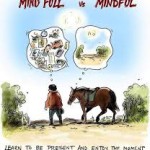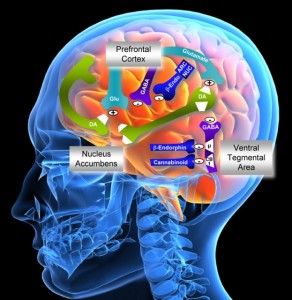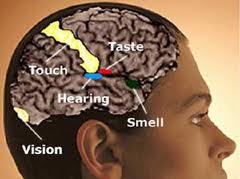Horse Sense


There are many kinds of meditation and all of them provide multiple benefits to anyone who practices. Mindfulness meditation is the underlying meditation in that it specifically deals with building the skill of paying attention. That skill comes in handy when practicing other kinds of meditation such as mantra, visualization, sound, prayer and more. Some meditations are connected to a religious or spiritual tradition and others are secular in that they are not connected to any particular tradition. Many people simply use meditation to explore awareness/consciousness and use that exploration to more deeply understand and experience life.
Meditation has been around for thousands of years and over the past thirty years Western science has confirmed what millions of people over thousands of years already know. Science and experience teaches us that meditation reduces stress and opens us up to new and deeper ways of experiencing life. Meditation therefore is for everyone, young, old and in between. Lately more and more children are learning to meditate, particularly mindfulness meditation, and the results have been very positive not only in their school studies but in emotional intelligence as well. We are finding that in fact children come to meditation easier perhaps because they haven’t had time to take on the resistance to it that adults experience. I’ve taught and written curriculum for thousands of children and have learned from them that the focus that comes through meditation is a natural experience that is available to all.
Learning meditation is like learning anything new. There is usually some kind of resistance and distraction is a major one. If we have a good plan for dealing with resistance and distraction then we are more likely to continue to practice. Setting up good habits for practicing meditation is an excellent way to begin. Here are five that I have found to be helpful.
1. Set up a regular schedule. We are creatures of habit so it is important especially in the beginning to set up a schedule that is the same everyday. I recommend picking a time in the morning that allows you to practice before your daily activity. It’s a great way to start the day and the effects of the meditation will continue with you throughout the day. This will have a very positive influence on how each day unfolds for you. Studies show that habits take about eight weeks to establish so be patient with yourself as you begin.
2. Create a meditation space. Set up a space where you can be comfortable meditating that has few distractions. Creating comfort is important to motivation and sustaining practice. Start with setting up a comfortable place to sit. Whether it is a cushion or a chair pick out something that will enhance comfort. Also, if possible make this space an expression of your meditation practice in that it should express silence, stillness and focus. In so doing it would be good to remove anything that can cause distractions such as phones, televisions and computers. Also keep the room at a moderate temperature.
3. Tend to your stomach. Get into the habit of meditating while your stomach is at ease. This is important and needs to be emphasized. Our stomachs have way more influence over us that we care to admit. If we are full then the stomach uses our energy for digestion. If we are too hungry then our stomach tries to get our attention to eat. Either way is a distraction. We want to be in the middle. Not too hungry and not too full. This will make meditation easier and is an important habit to create.
4. Be gentle with yourself. Some days meditation will be easy and some days not so much. Although there is a lot to be said for the discipline of sticking to a certain number of minutes regardless of difficulty there is also a lot to be said for being gentle with yourself particularly in the beginning. If you set aside thirty minutes for meditation and find that you are struggling, then it is fine to shorten the meditation to accommodate the resistance. Meditation is a journey, not a destination so we have no need to rush for results. Your practice will flourish in time and there is a natural rhythm that you will find that will allow you to be gentle with yourself as well as able to develop and sustain the habit.
5. Make a list of why your are meditating. Once you make your list of why you are meditating get into the habit of reviewing the list a least once a week. During times of resistance and distraction this list will remind you why you are practicing. The list can be revised when necessary and can be used to bolster motivation. The list can be long or short and can contain such things as reducing stress, communicating more clearly with yourself and others, having less fear, experiencing life with more joy, having more compassion, deepening understanding and creating more peace. Write down what is most meaningful for you and revisit your list on a regular basis.
6. Pick something simple like the breath to focus on in the beginning. When you notice that the attention is distracted, recognize the distraction and return to the breath. Do this as often as needed and understand that recognizing distraction is an important part of the practice. Embrace distraction in this way and you will create a successful relationship with your meditation practice.
I’m Struggling To Meditate And I Get Distracted Easily. Any Tips For Beginners? Read More »

I know this may sound a bit incongruous in light of my touting the benefits of mindfulness meditation for so many years but there are many kinds of meditation and mindfulness meditation is less prone to addiction than the others that I know of. Although I have seen mindfulness meditation addiction in rare cases (usually caused by a misunderstanding of approach) I have seen meditation addiction in many other cases. Some of the meditation approaches I am speaking of are mantra, visualization, breathing meditation/exercises(pranayama yoga), prayer, progressive relaxation, and concentration meditation that puts your focused attention on something outside of you. The reason these types of meditation can be addictive(but not necessarily) is because they can be very pleasant and can facilitate “escaping from situations that are unpleasant. Sound familiar? This is really the way all addictions start. We find ourselves in a situation that we don’t like and we look for ways to disconnect from the unpleasantness. Granted, there are much worse things to get addicted to, but ultimately we want to rid ourselves from these ways of disconnecting, come into the present moment and fully experience what life has to offer….pleasant and unpleasant.
So how do we know when we are addicted to meditation? When we are having great, pleasant, illuminating etc. meditations that end when the meditation ends we can suspect that there may be an addiction/attachment to it. There is also a tendency to spend more time than necessary in meditation. I’ve seen many people over the years who have great meditations but when they return to daily life there is no spill over of the experience. There is a return to the unpleasant situation that they left prior to meditation. In fact, they are using the meditation as an escape from their everyday life. As I mentioned before, all these different types of meditation don’t have to be addictive. The remedy to this situation is to be anchored in the present moment while exploring “other” experiences through the various types of meditation. As long as we bring this mindful quality to our explorations we avoid falling into the addiction/attachment/escape of our meditation adventures. Mindfulness is really too broad to be considered a meditation approach but in the kind of world that we live in it is so different than the norm that for now we can call it mindfulness meditation leading to mindfulness in daily life…the successful spillover of the meditation into every aspect of living.
Addicted to Meditation Read More »

In looking for the most direct way into the present moment experience it is often acknowledged that the breath is a great place to start. That may be true but certainly alongside the breath or not too far behind would be the 5 senses. Focusing attention on the 5 senses is a sure way to connect to the body and therefore bring yourself into the present moment. It’s also a fun way to enhance our life experience by going deeply into each sense. We can take turns isolating each sense and making that sense our object of attention in our mindfulness experience. There are some activities that allow us to explore all 5 senses. Eating is an example of such an activity and is a fun way to bring mindfulness into our everyday lives. Each sense allows us to deeply explore our experience and at the same time connects us with the present moment through our bodies. Mindful eating is traditionally done slowly but if time is scarce we can still eat mindfully at any speed. With the kind of lives we live in our culture we need to be able to adapt our mindfulness to the reality at hand. If that means being mindful and eating quickly…well then, so be it. Exercising the 5 senses this way can enliven senses that have been dulled by years of inattention.
….or you can combine all 5 senses into a holistic way of experiencing much like what was described in the classic sci-fi book Stranger in a Strange Land. In that book our world is viewed through the eyes of a Martian who is visiting our planet and experiences by “grokking” or blending all 5 senses into a holistic intuitive experience. From Wikipedia: “Grok /ˈɡrɒk/ is a word coined by Robert A. Heinlein for his 1961 science-fiction novel, Stranger in a Strange Land, where it is defined as follows:
Grok means to understand so thoroughly that the observer becomes a part of the observed—to merge, blend, intermarry, lose identity in group experience. It means almost everything that we mean by religion, philosophy, and science—and it means as little to us (because of our Earthling assumptions) as color means to a blind man.”
In my experience, the blending/merging of the 5 senses produces this Grok experience. This came with practice and seems to be a natural progression of fully experiencing the 5 senses. Grokking need not be reserved only for Martians… ????
The 5 Senses: 5 Doorways Into The Present Moment Read More »
In order to figure out why Mindfulness Based Stress Reduction programs are so effective we need to look at what it is and how that relates to the core of stress related issues. We have come to learn that stress plays a role in so many negative ways and finding an approach that diffuses the core cause of these issues is very important.
The biggest problem with stress is when it becomes chronic and we become stuck in the fight or flight response. At that point we begin to deal with all the physical, mental and emotional changes that are designed to help us in the short run but become problematic in the long run if the system doesn’t normalize and return to balance. In many ways we can think of mindfulness based stress reduction as the antidote to being stuck in fight or flight. In that way it addresses the core of the problem.
The primary coping mechanism in fight or flight is our ability to disconnect from what is happening in the present moment. Considering the original purpose of fight or flight is to assure our survival in a situation of danger, possible death or injury, the ability to disconnect from those unwanted experiences can be a welcomed strategy. Of course with chronic stress this disconnection stays with us over a long period of time. We disconnect from our bodies, emotions and mind which causes many problems. The definition of mindfulness is paying attention moment by moment in a non judgmental way. As an antidote it brings you back in the present moment…into your body, mind and emotions. In so doing it breaks the stress cycle and provides the impetus to return the system to normal. MBSR Scottsdale Institute for Health and Medicine serves the entire MBSR Phoenix area needs.
Why is the Mindfulness Based Stress Reduction Program So Effective? Read More »
If you would like to try a contemplative practice, but you’re not sure how to begin, we suggest you check out the Tree of Contemplative Practices. The Tree shows many examples of contemplative practices, and you may feel drawn to one or more. Follow your instincts and explore one or two practices that you find intellectually interesting and spiritually comfortable. Each practice listed on the Tree links to a page full of links and resources for learning more.
Try to commit to regular, perhaps daily, practice sessions. If you cannot stick to a regular schedule, persevere as best you can. As with most activities that have not yet become familiar and routine, it’s common to postpone engagement with contemplative practice because circumstances are not to your liking. It’s easy to make excuses about lacking materials, supplies, or adequate time and space (“if only I had a nice meditation cushion; if only I had a dedicated yoga room, and an hour free after work–then I could really do this…”). If you notice yourself doing this, try to use the situation as an opportunity to face your discomfort. Begin your practice. Really, you probably already have everything you need!
You can make things easier for yourself by committing to brief but regular sessions. For example, if you decide to take up a silent meditation practice, it is perfectly fine to begin with just a few minutes per session. After you’ve become accustomed to your short sitting periods, honestly and gently assess how that amount of time is serving you, and increase your practice time if it feels right to do so.
It is common to feel twinges of guilt or self-indulgence when you’re beginning a practice. For many of us, time is precious, and we face many demands from family, friends, and our jobs. In those moments when you question your priorities, remember that contemplative practices are not distractions or diversions from our daily activities, but are opportunities to get in touch with what is deeply meaningful to us. Have we lost the ability to be at peace in our moments of rest? Cluttered schedules not only constrict the time we have, but also manipulate our understanding of value and worth. It is crucial to remember the simple value and beauty of life as it is, not as it is used. The simple awareness cultivated by contemplative practices can bring us back in touch with this beauty, enriching our interactions with others.